Back to: Red Sea Reef Slope 2 of 5, On
to: Red Sea Reef Slope 4 of 5
Families Faviidae and Mussidae, the Honeycomb, Brain Corals.
Generally can be found in most Red Sea reef environments and at times
may dominate a given area. Faviids are represented here by the genera
Caulastrea, Erythastrea, Favia, Favites, Goniastrea, Platygyra,
Leptoria, Oulophyllia, Hydnophora, Diploastrea, Leptastrea, Cyphastrea,
Echinopora, Plesiastrea. Mussids have four genera present in the
Red Sea: Acanthastrea, Blastomussa, Cynarina and
Lobophyllia. Some more prevalent species:
| Favites abdita (Ellis and Solander 1876).
Colonies massive, rounded or hillocky. Corallites likewise rounded,
with thick walls. Septa straight, with exsert teeth. Bunaken,
Sulawesi, Indonesia and Red Sea images where it is
common. |
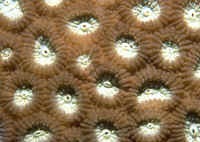 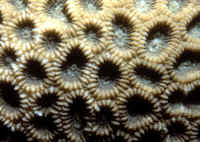
|
| Favites halicora (Ehrenberg, 1834).
Typically made up of irregular massive shapes. Corallites 11-13 mm
in diameter. Yellow-tan to greenish color. Here in the Gulf of
Aqaba, Red Sea and Fiji. |
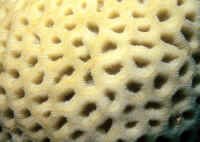 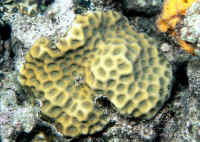
|
| Goniastrea edwardsi Chevalier 1971.
Corallites slightly angular, with thick, rounded walls. Irregular
septa that taper toward the columella. Thick paliform lobes.
Tan to brown in color, possibly with orange centers. Red Sea image.
Common, up to or more than a meter across. |
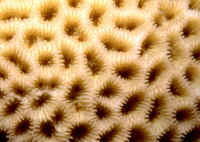
|
| Platygyra daedalea (Ellis & Solander
1786). Massive, encrusting to hemispherical colonies that are
meandroid, with corallites that are thick-walled. Exsert septa that
appear ragged. Color: Generally brown with green valleys. Common.
Red Sea images. |
| Echinopora lamellosa (Esper 1795). Thin,
wavy laminar sheets. Small corallites (3-4mm.). Indo-Central
Pacific including the Red Sea. Bunaken, Sulawesi, Indonesia
image. |
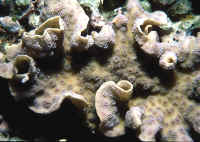
|
| Lobophyllia corymbosa (Forsskal 1775).
Colonies flat to hemispherical, large in the Red Sea (up to six
feet in diameter). Well separated calices. High, blunt septal
teeth. Colors are generally greenish brown with lighter oral discs.
Red Sea broken colony and close-up in Fiji. |
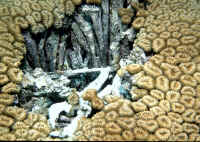 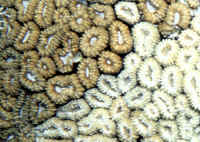
|
| Lobophyllia hemprichii (Ehrenberg 1834).
Flat to huge dome-shaped colonies of more than fifteen feet
diameter. Elongate to irregular corallites, often with contrasting
oral disc color. A common species where found. Easily kept in
captivity and fragged. Aquarium colony and one in Pulau Redang,
Malaysia. |
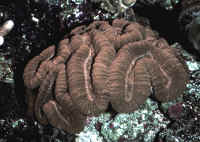 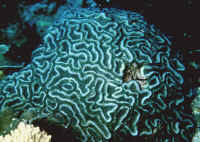
|
| Acanthastrea echinata (Dana 1846) Pineapple
Coral. Circular colonies tat are typically boulder-like. Septa with
long, pointed teeth (most easily seen in live specimens). Brown,
green to brightly colored. The most common member of the genus,
though this one not all that often seen. Maldives photo and
close-up. |
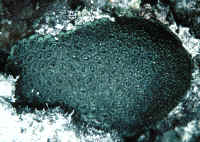 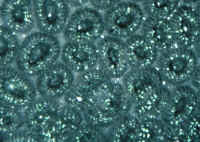
|
| Symphyllia (Acanthastrea in older
literature) erythraea (Klunzinger 1879). Massive
hemispherical colonies. Septa in two orders. Well formed
columellae. Waikiki Aquarium photo. |
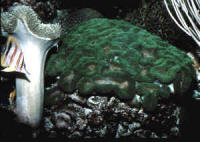
|
| Blastomussa merleti Wells 1961. Small
corallites Under 7mm. in diameter). Septa in two cycles, the larger
looking like white teeth. Mantles generally greatly expanded by day
(tentacles out only at night). Aquarium images. Easily
fragmented. A synonym of B. loyae according to Veron,
2000. |
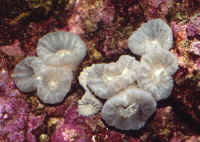 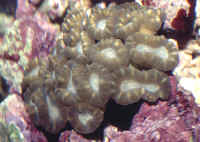
|
Family Pectiniidae: Three genera in the Red Sea;
Mycedium (one species), Echinophyllia (three spp.),
Oxypora (four spp.). Again, conspicuous when present, but not
often common species.
| Echinophyllia aspera (Ellis and Solander
1788). Common in all of its found regions, Indo-Pacific; Red Sea,
east Africa to Tahiti. Below: Close up of a day time
retracted/skeleton image in the Red Sea. |
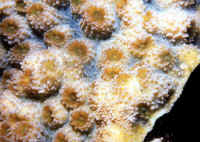
|
| Mycedium elephantosus (Pallas 1776)
Elephant Nose or Peacock Coral. Not commonly offered, though a
hardy, interesting coral, sometimes of great colors. Appreciate
bright lighting, mounting vertically or otherwise placed in areas
of low siltation. Red Sea and Fiji images. |
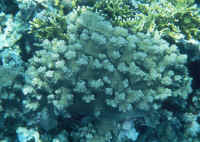 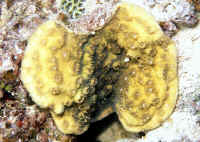
|
| Oxypora lacera (Verrill 1864) Scroll or
Chalice Coral. Composed of thin lamina that may be greatly
thickened in areas of substantial water movement. Costae toothed
(differentiating characteristic). Red Sea image. |
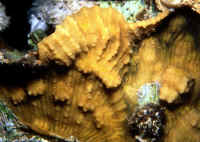
|
Family Dendrophylliidae: Pagoda, Sun, Cup Corals; represented
in the Red Sea by the distinctive species of the genera Tubastrea and
Turbinaria in shallow waters, and three deeper water genera.
| Tubastrea faulkneri Variously sold as
Sun, Orange Cup/Turret, Sunflower, Sun
Polyps... Circumtropical distribution. A can-be kept species
if you constantly feed its individual corallites, and can keep up
with concurrent water quality maintenance from the feeding. A group
in a typical reef lip setting in the Red Sea and in Australia's
Great Barrier Reef during the night. |
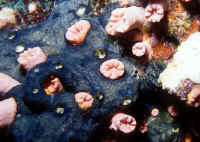 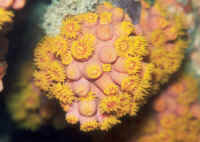
|
| Tubastrea micracantha (Dana 1849), Black Sun
Coral. External flesh (coenesteum) green to brown to blackish in
color. Colonies are often tree-like, up to a meter in height. Also
exceptional for the genus, T. micrantha is a poor captive
survivor. Consummate with its feeding habits are good current,
filtration to remove foods, wastes.. Generally found in areas of
good current. Red Sea in ten feet of water |
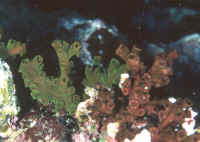
|
| Turbinaria mesenterina (Lamarck 1816).
Pagoda Coral to hobbyists, Bowl, Cup, Lettuce, Scroll Coral to the
trade. Indo-Pacific, Red Sea to Polynesia. Colonies laminar, more
convoluted in shallow waters to upright in deeper water (see
below). Corallites crowded, about 2.5 mm across, stick out further
than similar T. reniformis. Fiji images. |
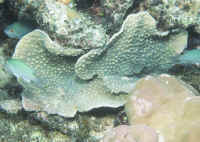 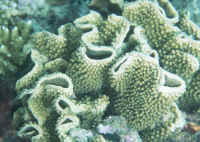
|
| Turbinaria reniformis Bernard 1896. Yellow
Scroll to aquarists (aka Yellow Turbinaria, Yellow Lettuce to the
trade). A hardy aquarium species. Typically yellow with distinct
colored margins. |
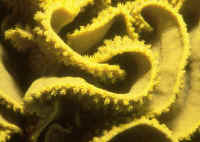 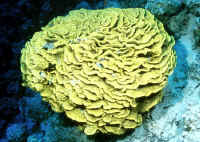
|
Worms of Many Kinds, but particularly the Polychaete Annelids
mainly knowns as "bristleworms" to aquarium hobbyists exist
in good numbers of individuals and species in the Red Sea. Vine (1986)
cites a study of a 4.7 kg lump of Pocillopora damicornis in
which 1,441 polychaetes were extracted, belonging to 103 species. Most
families of polychaetes have representatives here, but enthusiasts are
generally only interested in ones that are ornamental;
Featherduster/Fanworms of the families Sabellidae and Serpulidae. These
can/do occur in both the rocky and sandy reef slope environments.
| Sabellastarte indica (Savigny 1818), the
Magnificent Banded Fanworm. Cosmopolitan; all tropical seas. To
four inches in diameter (coronal head). The most common
"Feather Duster Worm" sold in the pet trade. These two
off of Gili Air, Lombok, Indonesia. |
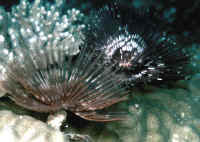
|
| Sabellastarte sanctijosephi (Gravier 1908).
Indo-Pacific; Eastern Africa to the Cook Islands. Image shot off of
Pulau Redang, Malaysia. Characterized by their two tentacular crown
head. |
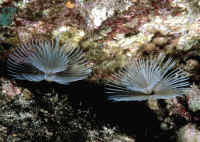
|
| Spirobranchus giganteus Pallas 1766, Horned
Christmas Tree, aka Bisma Rock Worms. Cosmopolitan; all tropical
seas. Most often found in association (burrowed in) Porites and
Millepora. To an inch in diameter. Hard to maintain in captivity
over any period of time. Need frequent particulate feedings, low
light. Pulau Redang, Malaysia photo. |
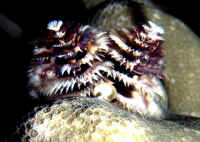
|
Crustaceans: The Red Sea is host to all the world's
tropical marine arthropod groups. Here we will (must) deal with those
groups and individuals most likely to be encountered. Principally the
Shrimps that are commensals with fishes and invertebrates that are sold
as such in the interest.
| Lysmata amboinensis (De Man 1888), the
Indo-Pacific White-Striped Cleaner Shrimp or Ambon Shrimp.
Widespread in the tropical Indo-Pacific and Red Sea. Can be kept
singly or in groups. A hardy Cleaner. Need hiding places to avoid
predators during molting periods. Conds: temp. 20-27 C. |
/Lysmata/Lysmata_amboinensis2.jpg)
|
| Saron marmoratus (Olivier 1811), Marble or
Saron Shrimp. Found throughout the tropical Indo-Pacific. Usually
collected out of Hawai'i for the U.S., the Red Sea for European
markets. Usually found in pairs in the wild. Will fight to the
death if same sex individuals are placed together. Males with much
longer first pair of walking/fighting legs. Get along fine
with fishes, other crustaceans. Female shown. Eat all types of
food, reclusive, nocturnal. |
/Saron%20PIX/Saron_marmoratusAQJar.jpg)
|
| Rhynchocinetes durbanensis Gordon 1936, the
Durban Dancing Shrimp. Indo-West Pacific; Red Sea to the
Philippines. Need reef tank conditions, but not with much light,
lots of hiding spaces. In the wild live in large
associations within rocky caves. |
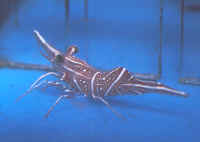
|
| Stenopus hispidus Olivier 1811, the Coral
Banded Boxing Shrimp. Worldwide tropical distribution. Males
smaller, more slender than females. Keep in reef settings with a
cave of their own. May consume small fishes, other crustaceans. Eat
most all meaty foods. |
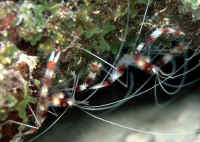
|
|
Panulirus penicillatus ( Olivier 1791),
the "Hawaiian" Blue Lobster,
typically collected out of Hawai'i for the trade, also found
in the Eastern Pacific. Conspicuous yellow white lines on brown
to green legs. No stripes on back. Dark green tail fan. To about
sixteen inches in length. A notorious
non-scavenger amongst aquarium lobsters.
|
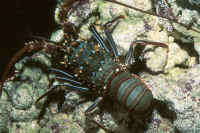
|
Sea Pens, Order Pennatulacea, Sea Fans, Order
Gorgonacea and Sea Mats, Order Zoanthidea, occur in the Red Sea,
but not in large numbers of species of use, availability to
aquarists.
Molluscs: Giant Clams, family Tridacnidae are also found on
Red Sea Reef Slopes (mainly T. maxima). There are a few
other notable, common bivalves here as well:
| Lopha cristagalli (Linnaeus 1758), the
Cock's Comb Oyster. Indo-West Pacific; including the Red Sea.
Characteristic "zig zag" shells. Can be kept in aquariums
lacking predatory starfishes. Filter feeders that can be serviced
by utilizing timers to shut off filter pumps temporarily. Attach to
hard substrates. Red Sea image. |
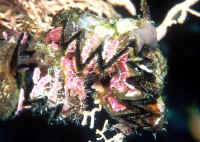
|
| Pedum spongyloideum (Gmelin 1791), the
Iridescent Scallop. Red Sea, Indo-Pacific. Live embedded in various
corals, usually Porites spp. Grow to a couple of inches across. Not
boring organisms, but preclude growth where they attach. Red
Sea image. |
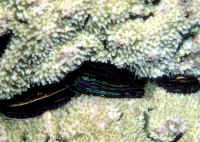
|
| Pteria aegyptica (Chemnitz 1782), Egyptian
Wing-Oyster. Indo-Pacific; including Red Sea. Found attached
to gorgonians (as here), stony corals, soft corals, hydrozoans.
Needs strong current, moderate light and very small (less than 15
millimicron diameter) for food. To 8 cm. in length. |
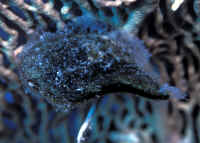
|
| Tridacna maxima (Roding 1798), the Large
Giant Clam. Has well-developed concentric growth folds. South
Africa to the Red Sea out to the Line Islands, but not in
Hawai'i. Common in its range. To about sixteen inches in
diameter. Characterized by elongate, triagonal shells, dense,
narrow-spaced folds on the shells (wavy appearance). Red Sea and
image. |

|
| Tridacna squamosa Lamarck 1819, the Fluted
Giant Clam. Distinguished by the presence of large leaf-like fluted
edges on its shell. South Africa to the Red Sea to the Marshall
Islands. To sixteen inches across. Relies on photosynthesis
for a major part of its nutrition. Red Sea image. |
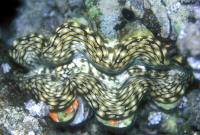
|
Back to: Red Sea Reef Slope 2 of 5, On
to: Red Sea Reef Slope 4 of 5
|
|

